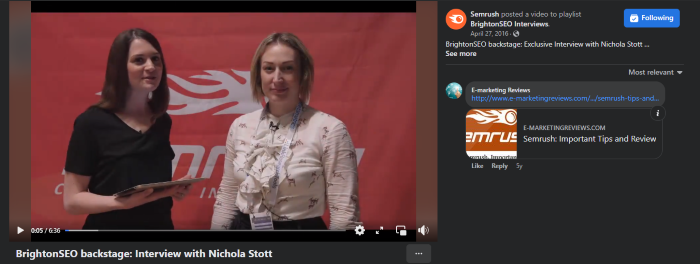In 2020, global online content consumption doubled. Today, the average person spends nearly seven hours a day consuming content online — which means brands have more time than ever to build relationships, establish trust, and market their offerings.
The problem? There’s also more content than ever before, making it hard to stand out.
According to the Content Marketing Institute, two-thirds of marketers plan to increase their budget for content marketing in 2022.
So how do you stand out? We talked to several content experts for their advice on using different content formats to break through the online noise.
Attract Leads And Build Brand Trust With Short Videos
Video consumption has exploded in recent years, with the average U.S. adult consuming 103 minutes of digital content per day. However, the production costs can be intimidating for many creative teams, particularly at smaller companies.
It’s time to overcome that fear, says Aaron Carr, a content strategist at Ubico. Aaron has amassed more than 30 million views and 130,000 followers on YouTube. “Don’t overthink it. You have everything to gain and nothing to lose.”
He says many people think they need a lot of money and top-notch production values to break into video, but he has found that authentic, simple videos — even talking directly to your phone — do best on social media, by far. In his words, “when you’re scrolling on Facebook, you don’t want to be advertised to.” So it makes sense that people on social media are drawn to authentic videos instead of polished commercials.
Short videos like Facebook Reels, TikToks, and Instagram Reels have driven users’ appetite for shorter videos, usually less than a minute long. YouTube also joined the short video trend by launching YouTube shorts.
Tori Dunlap, a financial coach dedicated to helping womxn build wealth, regularly posts short videos to Facebook, Instagram, and TikTok. Most videos are just a few seconds long, but she leverages the captions to establish trust and grow her brand.

Not sure how to use short videos? Here are a few ideas:
- Record short demos of new products or features
- Share clips of a recorded webinar or podcast
- Break a longer process down into 5 to 10 short steps
- Share quick advice or soundbites
- Answer FAQs
Short videos are flexible and take less time to create, making them ideal for any budget.
Use Live Video to Educate and Build Brand Trust
Live videos allow you to connect with your audience in real-time in a way that blog posts or recorded videos just can’t. Live videos also tend to come across as more natural and less recorded.
And they can help establish your brand as an expert in your field. A live video of you interviewing an expert, for example, can help educate your audience and establish your brand as an expert by association. Sharing your experience with a new tool or new strategy can help your audience trust you to be upfront.
Here’s an example from Semrush, a popular SEO tool, interviewing experts at a conference. There’s no fancy setup, but the content is still valuable.

Here are a few other ideas for live video content:
- Go live to share a demo or new feature
- Use live video for interviewing a current client, then turn it into a case study.
- Go behind the scenes at your office or production space and introduce your team
- Host a live Q&A session
One of the biggest benefits of live video content is it can be reused later by uploading it to Facebook and YouTube, sharing a clip to Instagram, even writing a blog post about it
Engage Site Your Audience With Augmented Reality
Augmented reality creates an interactive experience where computer-generated items are viewable in the real world. For example, Amazon lets users view large items like beds or couches in their actual homes using augmented reality.

This type of content is ideal for ecommerce shops because it helps users overcome online shopping hesitancy by getting a better idea of how an item looks in real life. But it can be used by brands in many industries.
Here’s another example from Pepsi Max:
This ad is engaging and a little disconcerting — but it grabs people’s attention.
Creating augmented reality is more complicated than recording a video or creating an infographic — but it might be more accessible than you realize. Apps like Overly and even Adobe provide access to AR creation tools for less than $100 a month.
While there is a learning curve, the results are worth it. One study found using AR in ads boosted conversions by 300%.
Use Interactive Content to Stand Out
In 2020, we created more than 2.5 quintillion data bytes a day. That’s a lot of blog posts, Tweets, YouTube videos, and Facebook updates. As a point of reference, 2.5 quintillion seconds is around 31,688,738,506.8 years.
That’s a lot of data — and a lot of noise.
Interactive content engages users and helps brands break through the content overload.
The most common type of interactive content is infographics, which presents key information quickly in a visual format.
Josh Miles, Chief Creative Officer at Killer Visual Strategies, a Seattle-based visual communication agency, says people have been communicating visually since prehistoric times and remain drawn to visual messages.
Infographics are particularly powerful when they use a narrative arch. Josh shares:
As you move through the different images and the different sections of text, you…should be able to not read the text and just see the images and get a decent sense of what we’re talking about — and with that final image feel like you’re back in that place of conclusion where we’ve returned to what that initial image is. But something has changed, some sort of outcome has been resolved.
Tools like Canva and Visme make creating infographics easier, even if you don’t have a designer in-house.
But infographics aren’t the only type of interactive content. Tools, like a mortgage calculator or Hubspot’s idea generator, engage users in a way a plain blog post can’t. They also offer opportunities for backlinks, which can improve search rankings.
Ebooks can also be interactive, like this one from Ceros that features elements that move across the page as users scroll down.
Quizzes, polls, games, maps, and interactive emails are easy to create and help snag users’ attention.
Use Podcasting to Build Relationships and Brand Awareness
Podcasts are more popular than ever. In 2021, 116 million people said they listen to podcasts at least once a month — a total of 41% of the population.
Steve Pratt, co-founder of Pacific Content, a Seattle-based podcast agency, says podcasts are highly effective at creating relationships with customers — and may be more accessible than many marketing professionals realize.
“You could do it at any scale, very similar to any other media — blogging or video,” he says. “The whole beginning of podcasting was about democratizing the tools and the distribution where anybody could do it for next to nothing, and that’s still true today.”
But that doesn’t mean podcasts are easy to churn out. He says a successful brand podcast registers high in “creative bravery.”
Your budget will influence what format you choose for your podcast — narrative storytelling or long-form interview, for example — as well as the amount of production that goes into the show and how often you produce it. But he says that regardless of the format if you have valuable information or stories to share with an audience, they will reward you with their attention and loyalty.
When it comes to format, remember that long-form, serialized, narrative storytelling can be difficult for smaller companies with few resources for marketing. “It requires a lot of expertise, time, and creativity,” he says. “That’s probably not something that’s a great fit to do in-house at a small company.”
But that doesn’t mean you can’t develop a narrative arc. Pratt suggests thinking about the order and type of questions you’re asking to try to build a sense of narrative progression.
Pratt says a high-quality podcast can build a powerful connection with customers in ways that other content rarely achieves.
“You’re getting people to spend a half-hour an episode over and over again with you,” he says. “They’re voluntarily spending their time with you and getting to know who you are and what you stand for. When it comes time to make a purchase or a decision, you’re way ahead of your competitors because of the relationships that have been built.”
New Content Formats Help Brands Stand Out Online
Content marketing is more competitive than ever. Luckily, new technology, like smartphones and content editing apps, make it easier for even small brands to create content in new, more engaging formats.
Podcasts, video, interactive content, even AR are no longer only accessible to large brands with even larger budgets. Start small, with short videos or infographics, and see how your audience responds. Over time, you’ll likely see an increase in organic traffic and sales, making it easier to justify investing time and resources into podcasts and AR.




